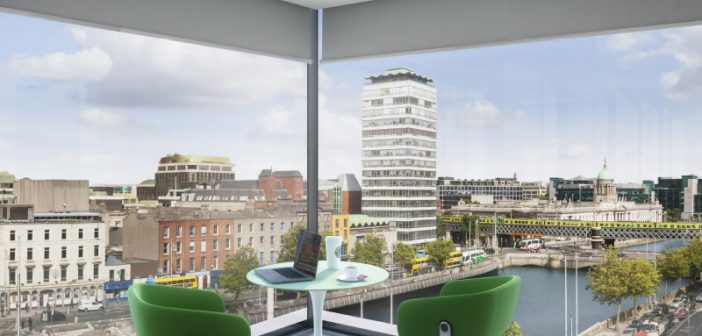Careful coordination and collaboration has transformed a brick and concrete 1970s office block in the heart of Dublin into a bright and light-filled space fit for modern businesses. Owner MF Properties, part of Irish developer Castlepark, approached Dublin-based architectural practice Lafferty in 2013 with a brief to completely refurbish and extend the property to create premium office accommodation available to let.
Following a protracted planning and appeals process, planning permission was granted in 2016 and MF Properties gave Lafferty the go-ahead in March 2017. The building is expected to be completed in early 2019.
Adding height and light
Comprising six storeys and a basement level, the original building was a concrete structure with brick facades. The project involved an extensive overhaul including the replacement of two of the facades, substituting the brick with an elegant Portland stone, enhanced with powder-coated aluminium floor-to-ceiling glazing.
The two upper floors provide penthouse accommodation with full-height, double-glazed facades, offering uninterrupted views of the river Liffey and surrounding area. External roof terraces at the penthouse levels offer attractive landscaped outside space.
According to Ronan Carroll, associate director at Lafferty, the floor-to-ceiling heights within the building were a complex challenge. As the original building was constructed with concrete, there was little opportunity to change the heights. This was of particular concern to the client, who was keen that the new space should feel both light and open.
After several investigations, Lafferty’s solution was to route the ventilation and services through the recessed profiles on the underside of the existing concrete slabs, instead of via the ceiling void, saving valuable height along the way.
“Graphisoft’s BIM software, ARCHICAD has been invaluable for this project,” explains Ronan. “The ability to view the building from all angles and to understand its complexity and geometry – I can’t imagine how we’d have done this using old school 2D.”
Complex project requires temporary steel frame
As part of the renovation, Lafferty worked with the structural engineer and steel subcontractor to construct a replacement structural frame on the two principal facades of the building. This required the construction of an additional temporary steel frame to hold up the floors until the new structural frames were put in place.
The structural and services engineers produced their model using Revit and this was transferred to Lafferty’s ARCHICAD model via IFC.
In this way, the team was able to coordinate the models and check for any coordination issues early on and throughout the project. During construction the steel fabrication model was provided for approval in a 3D format which greatly assisted the approval process.”
BIM coordination and collaboration
Lafferty employed an external BIM consultant for the project, who undertook the clash detection between the structural, architectural and services models using Solibri. Lafferty worked on the detailed design stage until the end of July 2017. IFCs extracted from the structural and mechanical and engineering models were imported into ARCHICAD and overlaid.
Close collaboration with the building contractor
Lafferty has also been heavily involved throughout the construction phase due to the complex nature of the project.
Ronan says: “There were no straight lines in the existing building, so it’s been a constant work in progress – we’ve continued to regularly update the BIM model and worked closely with the main contractor, Flynn Management, at every stage throughout the build.”
Collaboration, communication and coordination have been the critical factors throughout this challenging renovation. The end result will be an elegant building that both respects and enhances its prominent location in the historic Liffey Quays area of Dublin.
About Lafferty
Founded in 1997 and headquartered in Dublin, Lafferty is a design-led organisation offering core services in architecture and project management.
Lafferty has used ARCHICAD since 2003 and it has been the practice’s default software on all projects since 2009.
Learn more about ARCHICAD at www.axonware.com/archicad




